
Credit: ESO, Stefan Gillessen (MPE), F. Eisenhauer, S. Trippe, T. Alexander, R. Genzel, F. Martins, T. Ott
If the stars should appear but one night every thousand years how man would marvel and stare.
Ralp Waldo Emerson
 Credit: ESO, Stefan Gillessen (MPE), F. Eisenhauer, S. Trippe, T. Alexander, R. Genzel, F. Martins, T. Ott |
If the stars should appear but one night every thousand years how man would marvel and stare. |
| The brightest stars have names that derive from (usually) Arabic: e.g. Ursa Major |
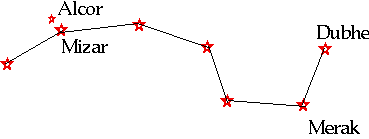 |
Subsequently stars named with Greek letters, in order of brightness:e.g. Orion
|
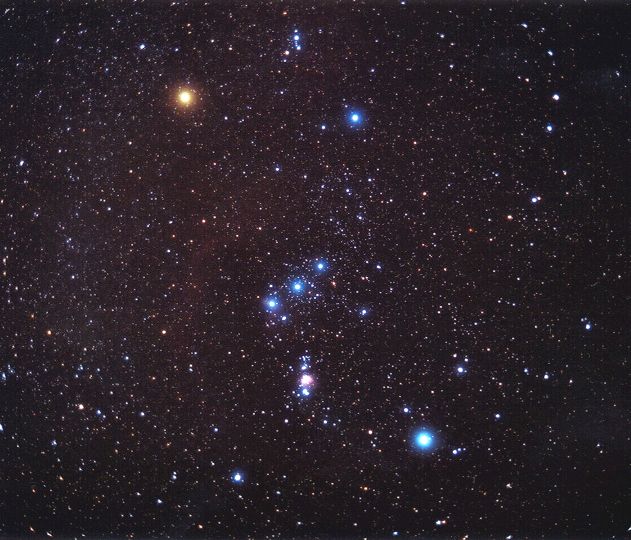 Credit & Copyright: Matthew Spinelli |
The most useful catalogs are ones of specific objects: e.g. Messier (pr. Messié!)
the most famous catalog consists of things that aren't comets(!):
|
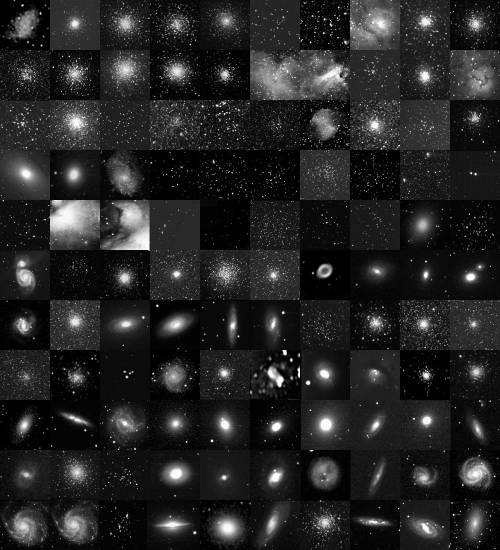 Credit & Copyright: P. Gitto |
Easiest observation about stars is that some are brighter than others.
Hipparchus defined brightest to be of first magnitude, down to the dimmest of sixth magnitude.
A first mag. star turns out to be 100xbrighter than a 5th mag.
before we get started,
(note in passing: we talk about stellar evolution, which is stupid, since we don't talk about the evolution of a baby into an adult.)
Also note: ALL stars go through ALL the stages: the reason why we only see (e.g.) 100 or so planetary nebulae vs 108 normal stars is that the lifetime of a planetary nebula is only ≈ 50000 yrs, vs 1010 yrs for a main sequence star
Solar mass stars: Times are approximate in years. |
 |
| Large Mass stars
Endpoint depends on mass of star: Note lifetimes are much shorter. |
 |
My candle burns at both ends It will not last the night, But ah my foes and oh my friends, It gives a lovely light.Edna St Vincent Millay
Note
|
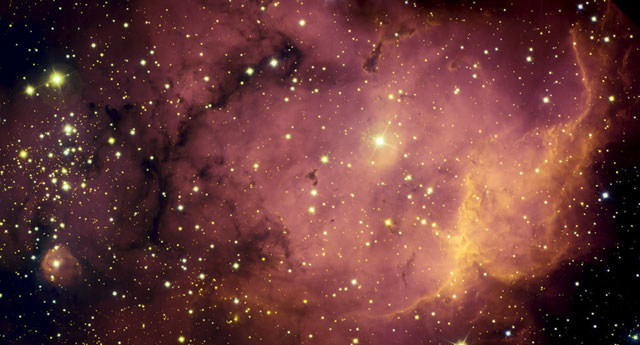 Credit & Copyright: T. Rector (U. Alaska Anchorage), Gemini Obs., AURA, NSF |
| Eagle Nebula: Cluster of stars just formed in centre of dark shell of dust and gas, taken with the 0.9-meter telescope on Kitt Peak, Arizona, USA. Part of M16 | 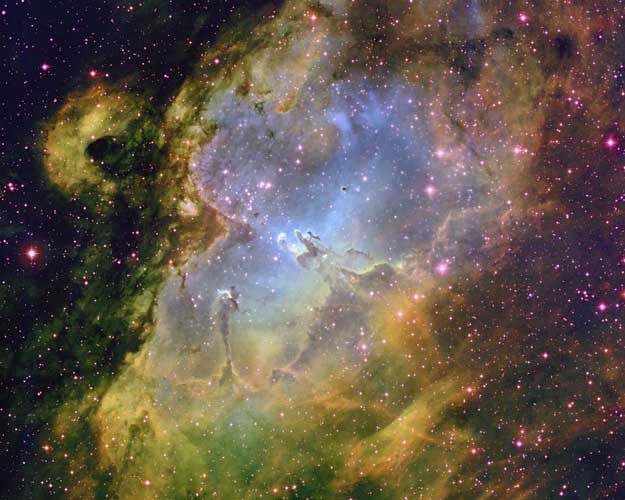
Credit & Copyright: T. A. Rector & B. A. Wolpa, NOAO, AURA, |
| Eagle close up: pink light is sulphur. Young stars excite the gas so it glows around the "birth pillars". Large stars will go supernova in about 5 million years | 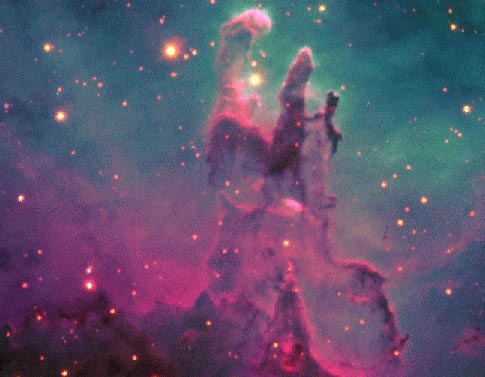 Credit: P. Challis (CfA), Whipple Obs., 1.2 m Telescope |
| The Eagle's EGGs: evaporating gaseous globules (EGGs). Very dense parts of the Eagle contract to form new stars which promptly blow away the surrounding dust and illuminate the columns | 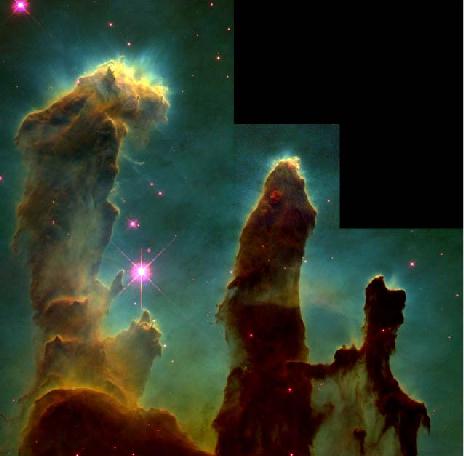 Credit: J. Hester, P. Scowen (ASU), HST, NASA |
| Henize 206: Another star forming region in the Large Magellanic Cloud. Can see left over remnants of old supernova at the top, which compressed the gas and triggered the star formation | 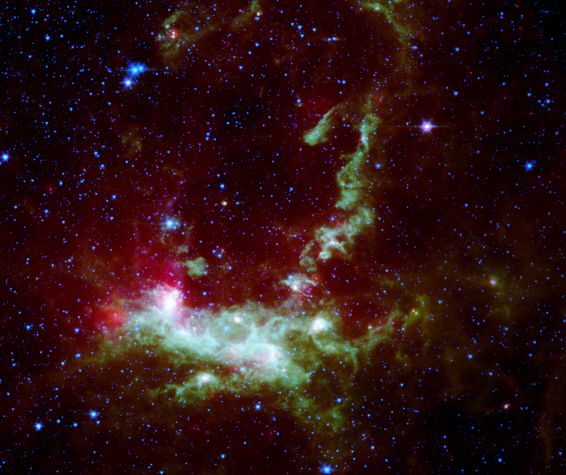 Credit: V. Gorjian(JPL) et al., JPL, Caltech, NASA |
| N81: a group of very young hot stars in the Small Magellanic Cloud heating up the nebula round them | 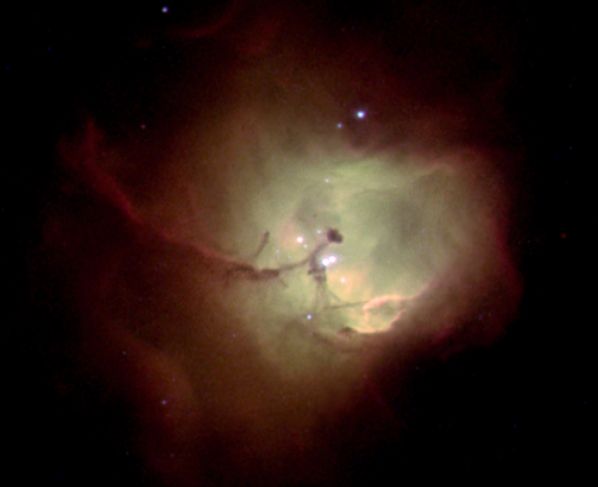
Credit: M. Heydari-Malayeri (Paris Obs.) et al., Hubble Heritage Team, NASA |
| XZ Tauri consists of 2 very young unstable stars, separated by about Sun-Pluto distance, emitting vast cloud of gas (pictures taken over 5 years) | 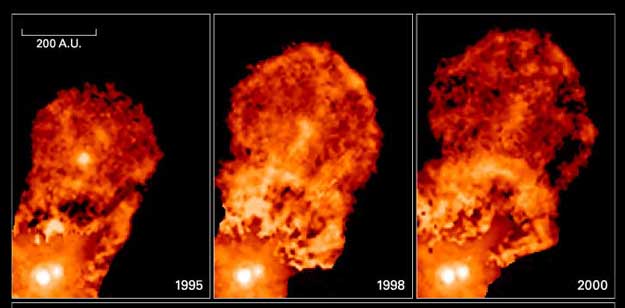 Credit: John Krist (STScI) et al., WFPC2, HST, NASA |
| The best known cluster is the Pleiades: (Seven Sisters except we can only see 6 now) |  |
| A closer look: the Pleiades are a very young group (∼ 50) of stars, about 107 years old, and very close: about 40 light-years, so light takes 40 years to travel from them. Note the "star-stuff" still blowing away. | 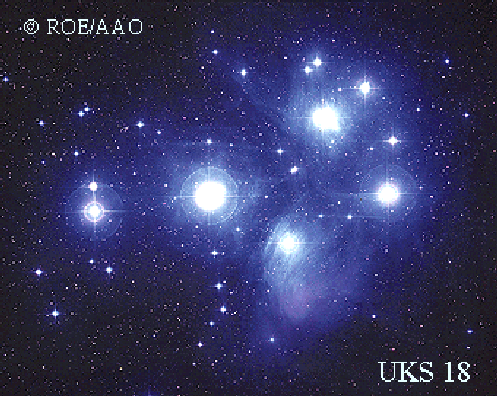 |
Cannot measure energy output of most stars directly (too little!) hence can't measure temp via BB curve as we did for the sun. However spectra vary from one star to next.
Vega

Aldebaran
Note hotter (bluer) stars show more H, less complicated spectrum
| This provides a direct measure of the surface temp of the star. This allows us to classify stars according to their spectra | 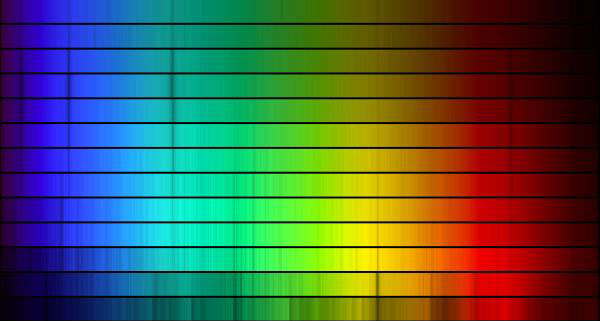
Stellar Spectral Types: OBAFGKM Credit & Copyright: KPNO 0.9-m Telescope, AURA, NOAO, NSF |
| O | Hot Blue stars | T>30000 | prominent HeII and ionized metals. |
| B | Blue | 30000>T>15000 | HeI & strong H lines. |
| A | Bluish | 15000>T>10000 | H and FeII. |
| F | White | 10000>T>7000 | H, CaII and neutral metals. |
| G | Yellow | 7000>T>5200 | CaII & neutral metals. |
| K | Orange | 5200>T>4500 | neutral metals. |
| M | Red | 4500>T>2500 | neutral metals & TiO. |
| CRNS | all cool stars | different concentrations |
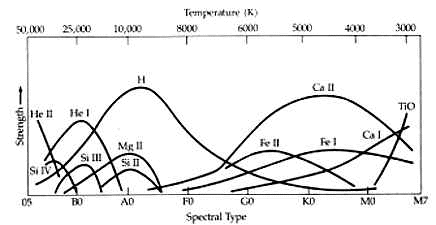
These are subdivided into 10 smaller classes running from 1 to 10: e.g. the sun is a G2 star.
| A mnemonic |  |
The classic example is M57: The Ring Nebula
|
 Credit: H. Bond et al., Hubble Heritage Team (STScI /AURA), NASA |
| The star blows away its outer layers, so almost all the older ones we knew look like this. | 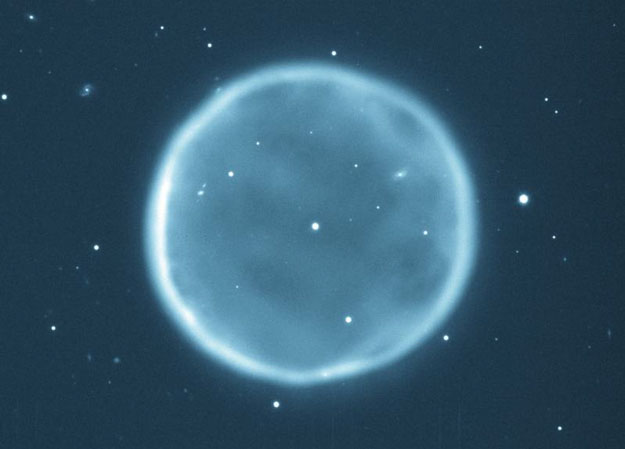 |
| or like this |  |
| This is the Cats-eye nebula: looks like successive explosions | 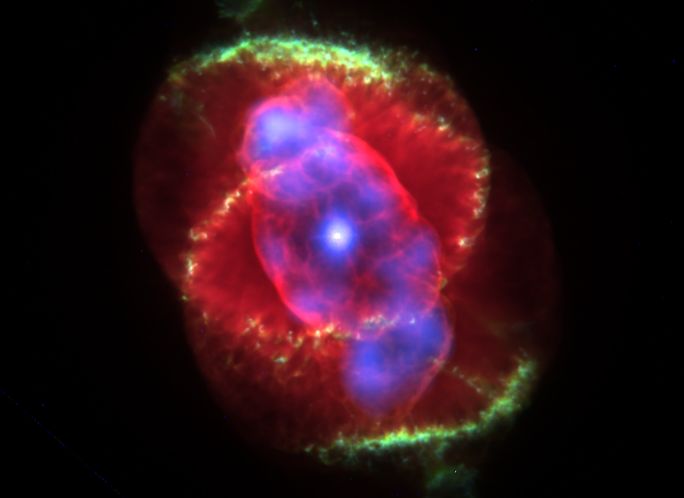 |
| Mz3: The Ant Nebula. Probably magnetic field is creating a "focussed" planetary nebula | 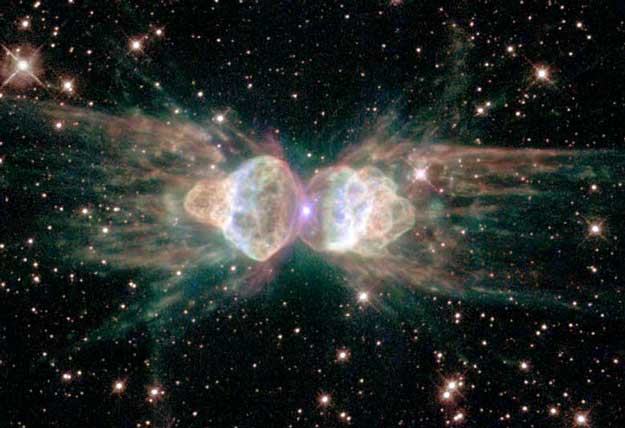 Credit: R. Sahai (JPL) et al., Hubble Heritage Team, ESA, NASA |
| Planetary Nebula CRL 618: this was a red giant a few hundred years ago, but it is now expelling jets of gas | 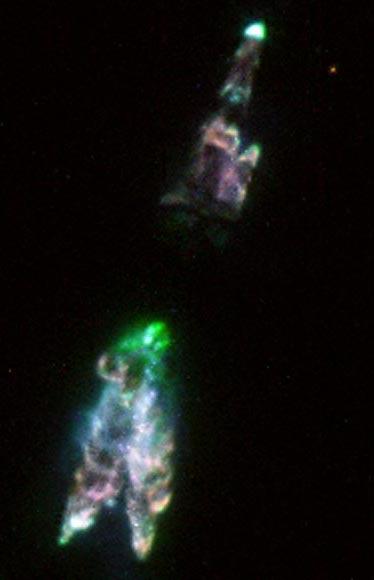 Credit: Susan R. Trammell (UNC Charlotte) et al., ESAIC, HST, ESA, NASA |
| NGC 2440: a very hot white dwarf which is blowing off its outer layers much faster |  Credit: H. Bond (STScI), R. Ciardullo (PSU), WFPC2, HST, NASA |
| IC 4406: a really weird planetary nebula: probably a cylinder that we see side on. How can a round star make a square nebula? IC 4406 is most probably cylindrical, with its square appearance the result of our vantage point. |  Credit: H. Bond (STScI), R. Ciardullo (PSU), WFPC2, HST, NASA |
Approx 1/30 yr known in Milky Way
6 visible in recorded history
| 1006 Type I SN 1006: History's Brightest Supernova. THis shows remnants of the expanding shockwave |  Credit: Frank Winkler (Middlebury College) et al., AURA, NOAO, NSF |
| 1054 Type I Crab. Superimposes X-rays and optical | 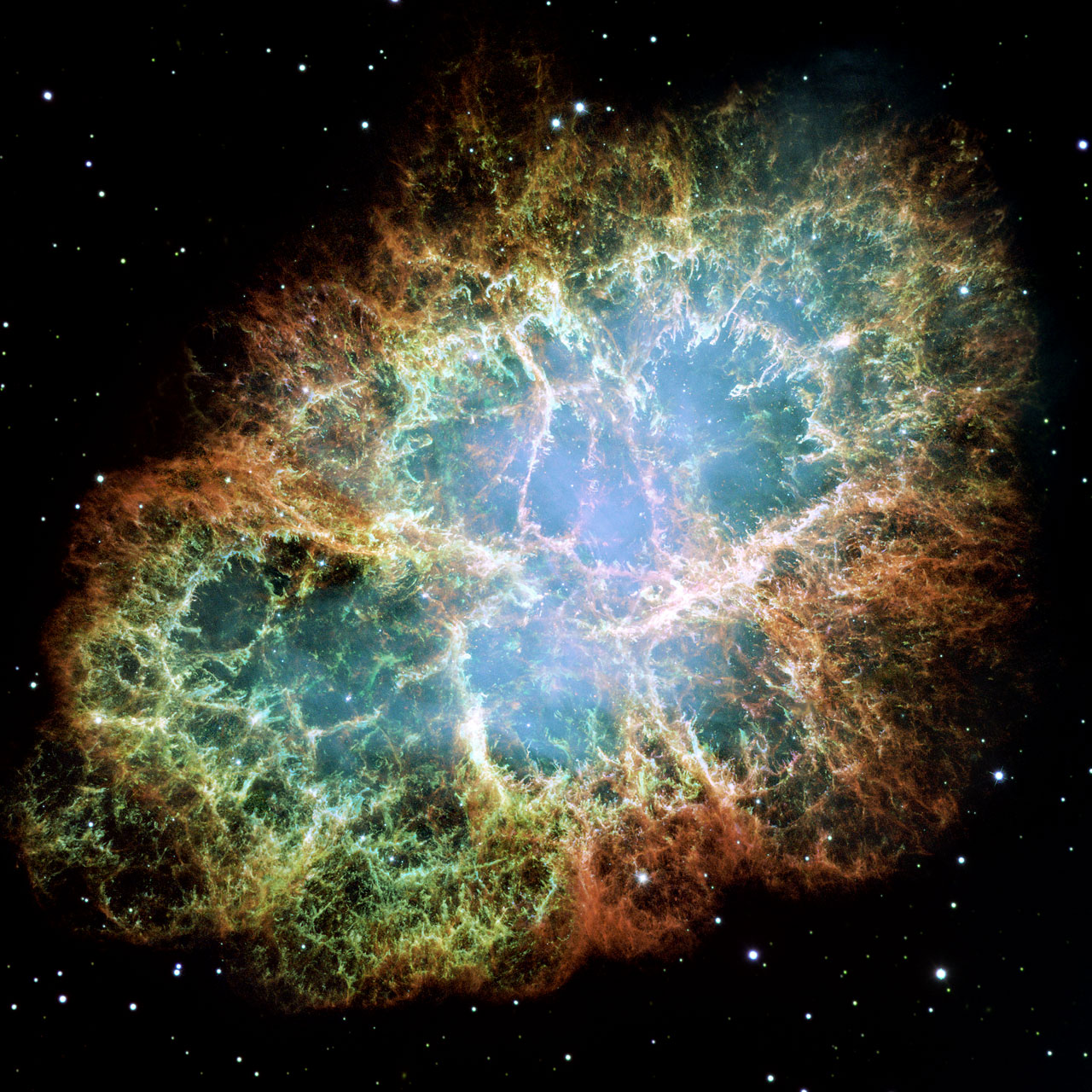 |
| May have been observed by Chaco Indians in New Mexico | Ron Lussier |
| 1181 Type II. Now seen as radio source 3C58. THis is in X-rays | 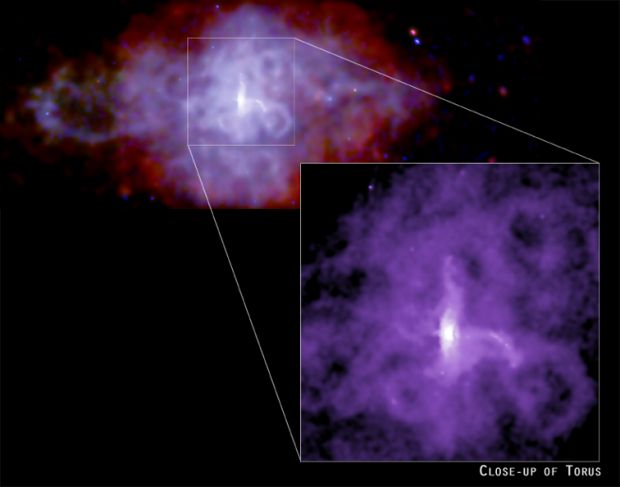
Credit: P. Slane (Harvard-Smithsonian CfA) et al., CXC, NASA |
| 1572 Type I Tycho Gas is still very hot, so produces X-rays,seen in blue at front of blast wave | 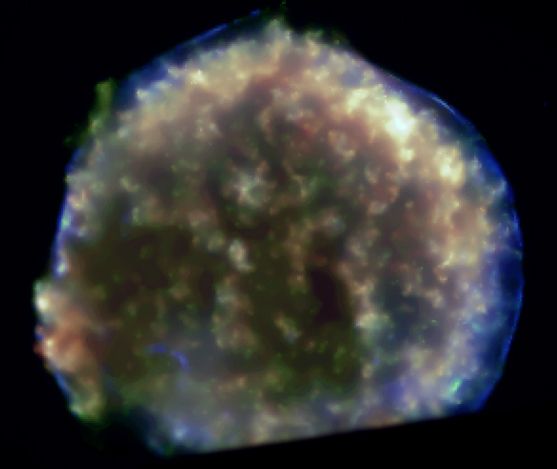 Credit: SAO, CXC, NASA Credit: SAO, CXC, NASA
|
| 1604 Type I Kepler. Temps still in excess of 1000000°C | 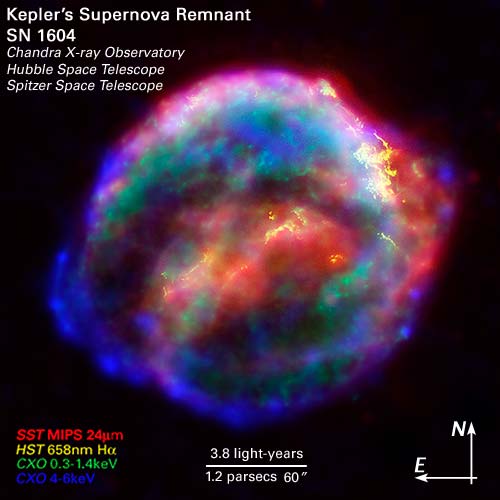
Kepler's SNR from Chandra, Hubble, and Spitzer Credit: R. Sankrit and W. Blair (JHU) et al., ESA, NASA Graphic: courtesy STScI |
| 1667 Type II Cas.A | 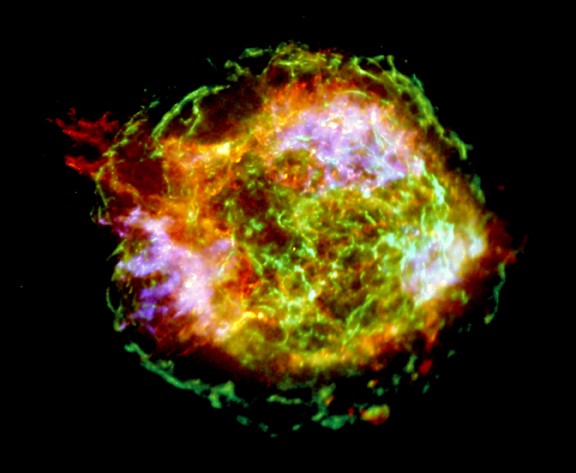 Credit: U. Hwang (GSFC/UMD), J.M. Lamming (NRL), et al., CXC, NASA, |
2 Kinds, distinguished by light curves
TYPE IDecay rapidly for 30 days, exponentially afterwardsIn all galaxies TYPE IIRapid decay -> Plateau->Rapid decay |
 |
Type 1 have a compact object (white dwarf) with a red giant, which expands and spills material onto companion, finally triggering catastrophic collapse. All type 1a seem to be the same (very important for later on!)
|
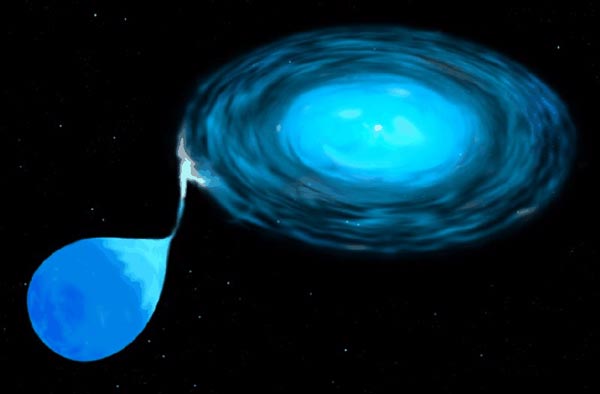 Drawing Credit: ST ScI, NASA |
| Supernova 2005cs in M51 (see center of right image). Blue supergiant, type II. Discovered by Wolfgang Kloehr, June 28, 2005 |  |
Many in external galaxies:spectrum show ejected material has v - 10⁴ km s-1
Photographically February 23rd (unit is fraction of day!)
| v. fast initial rise, then increase to plateau |  |
3 hours before the light arrived a pulse of neutrinos hit the various detectors running at the time (Kamiokande, Mt.. Blanc) Theoretically predicted but never seen before or since.
Star could be identified with known one in catalog Sk-69°202 in Lesser Magellanic Cloud (first time we have been able to do this!) Distance ∼ 156000 lys ∼ 50 kpc |
 |
| Progenitor was blue(!) supergiant
M ∼ 20M₀ May have companion star but definitely type II. Surrounded by rings before explosion |
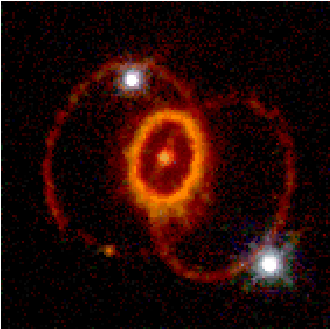 |
| Can now see blast wave from explosion hitting rings of material previously ejected | 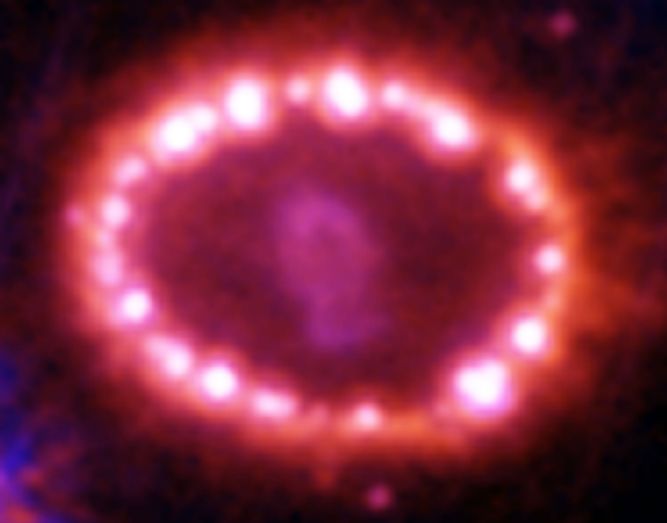 Credit: P. Challis, R. Kirshner (CfA), and B. Sugerman (STScI), NASA |
| Eta Carinae blew off a lot of material 150 years ago: probably pre-collapse now |  Credit: J. Morse (U. Colorado), K. Davidson (U. Minnesota) et al., WFPC2, HST, NASA |
| The Crescent Nebula is s shell of gas surrounding a central Wolf-Rayet star WR 136 (very hot and unstable). Should undergo a supernova explosion in next million years. | 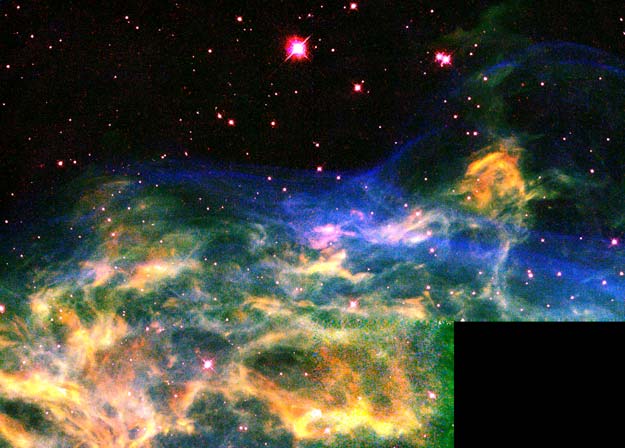 Credit: Brian D. Moore (ASU) et al., WFPC2, HST, NASA |
| NGC 3603: can see formation of stars and probably pre-collapse Sher 25 surrounded by rings | 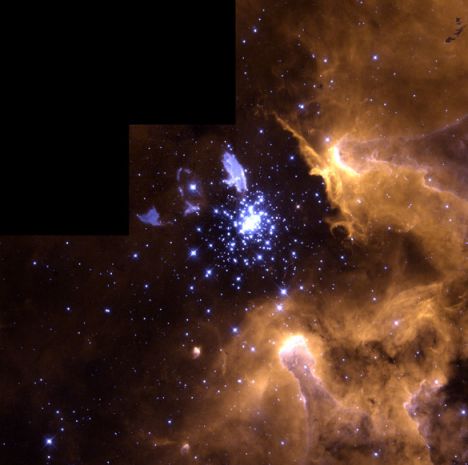 Credit: Wolfgang Brandner (JPL/IPAC), Eva K. Grebel (U. Wash.), You-Hua Chu (UIUC), NASA |
Means......
Mass is the critical factor for "normal" stars: the other important parameter is density
(these are old units: if you compare to a modern book, multiply all densities by 1000)
As seen in planetary nebula: star with about the same mass as sun but size of earth (∼10000 km )
Density: ∼ 106: ∼ 100,000 times as dense as lead.
| This shows some in M4 (a rich globular cluster of stars). temperature very hot: T ∼ 50000°C: since they are small, they cool very slowly. |
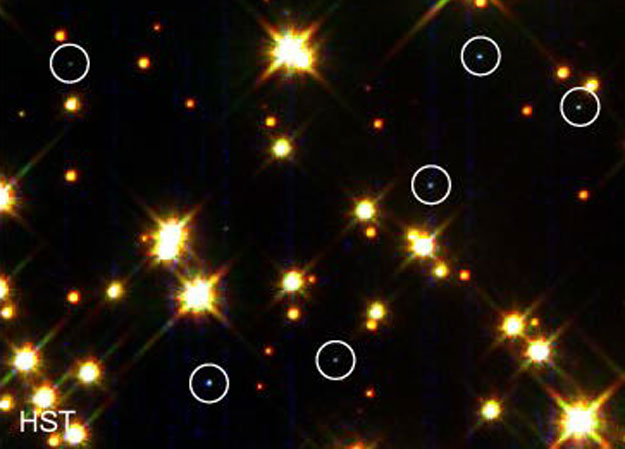 Credit: NASA, HST, WFPC 2, H. Richer (UBC) |
"Found" by Herschel who noticed Sirius was "wobbling". Observed in 1862 by Alvan Clark: very hard to see since it is close to Sirius A but 1/10000 of the brightness, but mass ∼ 1.05 Mo. This implies a very small object:
|
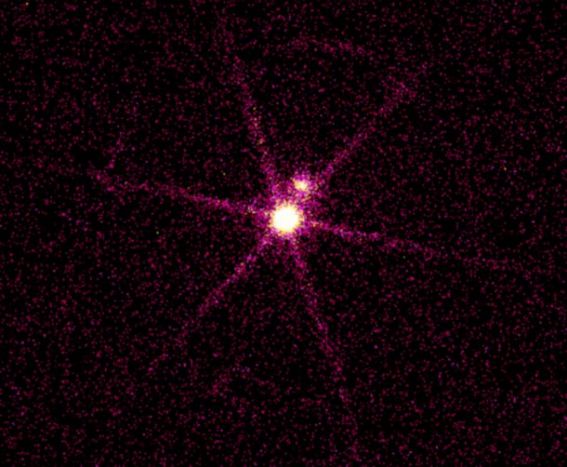 |
| What Sirius might have looked like: NGC 3132 (the Eight Burst Nebula), a recently formed planetary nebula with a white dwarf and companion, will probably look like Sirius in 100000 years | 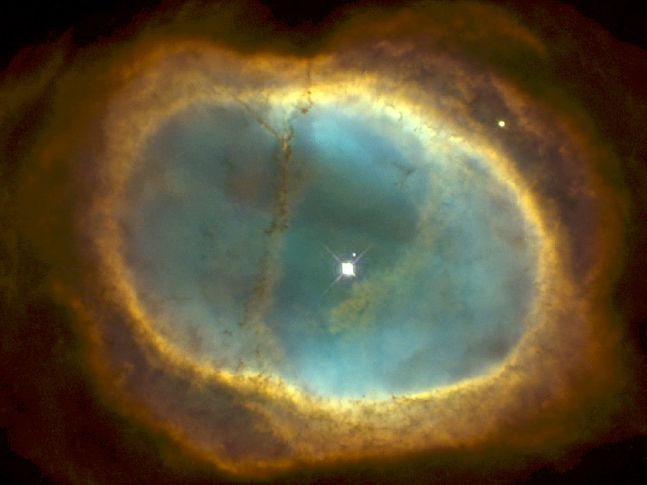 Credit: Hubble Heritage Team (AURA/STScI /NASA) |
| Very regular radio pulses, period of 4 s ⇒ 2 ms Note that height of pulse is very irregular |
 |
| All lie close to Milky Way (i.e. in plane of galaxy).
Therefore must be related to stars |
 |
| Best known is Crab Pulsar at centre has period of ∼ .03 s. This shows how the X-ray pulses move through the nebula |
| Optical pulsing observed by TV or strobe |  |
| Pulses at all wavelengths, in synch. | 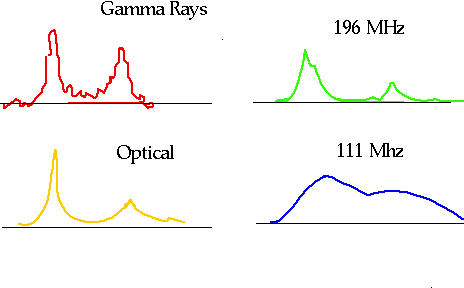 |
| And we can listen to them! |
| What pulses? Now known to be neutron star: predicted by Oppenheimer (yes, that one) in 1935. Density ∼ 1000000000000000 times as much as water! Magnetic field is very strong: ~ 1 trillion times stronger than earth. Charged particles travel along lines of force, hence can only escape from poles of neutron star. Hence "lighthouse"mechanism: we only see pulsar when mag. pole points towards us |
Do we see all the pulsars?
No, because they would have to be oriented so that they point towards us. rotation period will slow down...
| Hence probably large number of radio-quiet neutron stars: essentially impossible to see. Since neutron stars are so hot we see them in X-rays and γ-rays. This shows how a new satellite (GLAST) will see the sky: the brightest object is the Crab and the second brightest....... Geminga: a pulsar that had only been seen in γ-rays until it was identified as a very faint star |
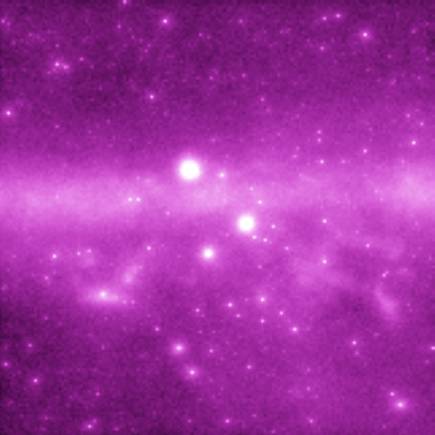 GLAST Gamma Ray Sky Simulation Credit: S. Digel (USRA/ LHEA/ GSFC), NASA |
G = 6.67x10-11 is Newton's constant, M is the mass of the object from which you are launching, so for the earth is 6x1024 kg and m is the mass of the object. Note P. E. = 0 at r=∞ . The kinetic energy is Total energy is conserved, so at Earth's surface
Statutory Warning:This is a fudge: you cannot treat light as a massive particle, nor can you handle a very strong gravitational field as if it were a weak one......
(there are actually two factors of 2 error which cancel out.....weren't we lucky!)But black holes are black:

as the bumper sticker says. So how do we see them?
| If we are really lucky....(or unlucky) as a gap in the sky | 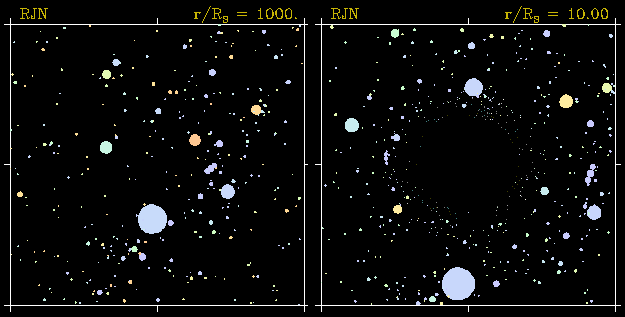
Too Close to a Black Hole Credit & Copyright: Robert Nemiroff (MTU) |
| But more likely via the "accretion disk" which will have velocity ∼ c at inner edge, so temp well into X-rays | 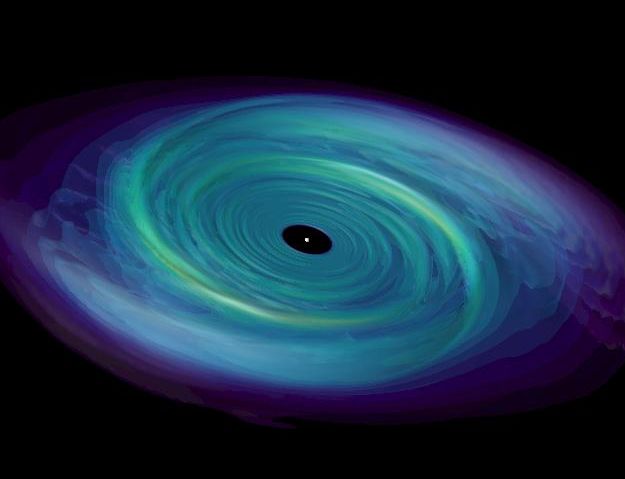 |
So want binary, with invisible heavy companion with M > 3M₀, emitting X-rays
Prime candidate is Cygnus X-1, which agrees with position of a massive blue star HD 226868
| SS-433 found as star with very unusual spectrum X-ray source discovered at same positionSpectrum changes with 164 day cycle, corresponding to v ∼ 50000 km/s |

|
| This is something new! Narrow jets travelling at 1/5 speed of light are shot out of poles, probably formed by thick accretion disk around neutron star or black hole: "cosmic lawn sprinkler" |  |